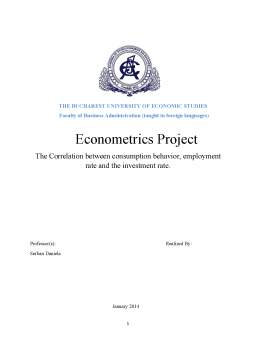Extras din referat
INTRODUCTION
The regression analysis is a statistical forecasting model which its main purpose is to describe and to assess the relationship between a given variable called a dependent variable, and one or more independent variables.
The regression analysis is used to predict the value of one variable from one or more variables whose values can be predetermined.
The present project intends to observe and to interpret the correlation between the consumption behavior in the most important European countries, and the employment rate of the labor force for the same countries using the simple regression model. As far as the multiple regression model concerned, it will be taken into consideration the investment-savings rate for the same countries as the second independent variable.
The analysis is based on information collected from ec.europa.eu/Eurostat and the sample contains data on 10 European countries: Belgium, Germany, Italy, France, Luxembourg, Denmark, Spain, Netherland, Britain, and Ireland. The study was realized for the third quarter of the year 2013.
The variables used are the consumption volume rate as dependent variable(y), and the independent variables such the investment rate(x1) and the employment rate(x2).
The consumption function shows how much a household wishes to consume at each level of income and interest rate. Consumption increases with income and decreases with the interest rate. But when it comes to talk about consumption it need to be mentioned that it is strict related with the savings function. Savings increase with income and increase with the interest rate.
Investment refers to business investment in new plants, equipment, and inventories. The purpose of investment is to increase productivity, efficiency, and output of goods and services.
More investment in infrastructure means more economic development, an increased rate of employment, more buying power of the consumers which would lead to a higher consumption rate.
Through this analysis, I tried to find out whether the consumption rate is influenced or not by the employment rate from the same country, and as well as between the consumption and the level of investment.
2. Hypothesis Testing
a) For the hypothesis testing it was selected a sample of 6 countries from the northwestern part of Europe, in which the investment rate was found 3.3points with a standard deviation of 3.89. For the southern part it were selected 4 countries with an investment rate of 2.225 points and a standard deviation of 4.20.
It is claimed that the rate investment in the northwest part is higher than the one for the countries located in the southern Europe.
The initial hypothesis is that the average investment rate for the both northwest and southern countries are equal.
The alternative hypothesis is that the average investment rate is higher for the northwest countries than for the southern side.
H0:u1=u2=>u1-u2=u2-u1=0
H1:u1>u2=>u1-u2>0
We will perform the test to the right.
Cut off value: 1.645
RR: (+1.645, +∞)
Zcalc = (x1-x2)/√(s1/n1+s2/n2)
Zcalc = (3.3-2.2)/√(3.89/6+4.20/4)=0.8
Z calculated is 0.8 which does not fall into rejection region, so in 95% of the cases we cannot reject Ho. Therefore, it can be said that the investment rate is equal for northwest countries and southern countries.
b) Another important factor that influences the consumption volume is the employment rate. Another statistical data from another website stated the average employment rate in the countries in reference is 0.41 and the standard deviation for the sample is 1.75. The test is performed to check if the results are really different or not.
Ho: u= 0.53
H1: u< 0.53
It will be performed the test to the left.
Bibliografie
http://epp.eurostat.ec.europa.eu/portal/page/portal/eurostat/home/
Preview document
Conținut arhivă zip
- The Correlation Between Consumption Behavior, Employment Rate and the Investment Rate.docx










